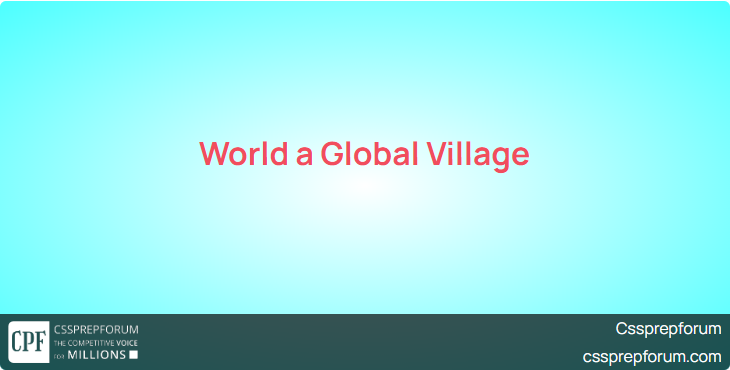Written By Irum Moin
1. Introduction
Globalization has led to the economic, political, and socio-cultural integration making the world a global village. The prospects of learning to live together are, however, still evolving amid the hurdles persisting to check its course.
2. Aspects of the Global Village
– Globalization of economy
– Global integration of politics
– Global village of socio-cultural integration
3. Contemporary Manifestations of ‘Learning to Live Together in Global Village’
– Internet and its global use
– International Political Community
– Global Economic Organizations
4. World Learning To Live Together
– The case study of Iran and P5+1 Nuclear Deal
– The Melting of Ice between Cuba and the US
– The traditional rivals of South Asia and the efforts to live together
5. Hurdles in the Learning of Global Village to Live Together
– Criticism on globalization as a threat to national interests
– The gap between the Global North and the Global South
– Economic, literary, cultural and technological backwardness
– Clash of Interests
– Clash of Civilizations
– Weak international institutions
6. Ways to Learn to Live Together
– Strengthening global institutions
– Minimizing the ideological difference between civilizations
– Pursuing mutual interests and fighting common threats
– Liberalism of trade
– Dialogue to be the first choice of conflict resolution
7. Conclusion
The world is called a global village by the virtue of globalization which is a multi-faceted process. Globalization is the integration of everything. It can be the integration of political, cultural, and technological prospects. The most apparent manifestation of globalization is economic and political integration. Similarly, globalization which plays a major role in making the world a global village comes in the shape of technological integration.
The global village is attributed to sharing information, products, investments, and profits. In political terms, the global village is featured by the presence of an evolved international community at the platform of the UN. The growth of an integrated village brings several benefits to the masses as well as states along with causing trouble for the national interests.

Considering the dimensions of the global village, economic integration has brought the world closer and dependable on each other. Multinational companies, global economic forums, and cross-border investments; all play a vital role in making the world a global village.
Political integration of the world states which helps to unite the global village becomes obvious at the platform of the United Nations. This institution has 193 member states which discuss and decide upon all the important political events of international prospects. International political security, regional and global alliances against terrorism, international treaties on nuclear non-proliferation; all reveal the political integration of the global village.
Another important aspect of the global village is socio-cultural integration. It is the mixing of cultural values and customs to evolve the new ones. The apparent manifestation of socio-cultural integration in the global village comes in the shape of fashion, traditions, and practices one adopts after getting inspired by another culture through books and movies most of the time.
These all aspects of globalization render the global village to learn to live together. This becomes possible when the world states interact and find mutual interests. Those interests might be political, economic, or social.
Multinational organizations and global institutions represent another manifestation of how the world is learning to live together. European Union, for example, represents the togetherness of the European nations. Similarly, ASEAN is the association of southeast Asian nations for attaining definite economic goals. In South Asia, SAARC emerges to be an organization for regional cooperation. IMF and the World Bank bring the world closer in monetary aspects. Muslim states of the world form OIC as their distinct body. NATO is a military alliance of European and American nations. Thus, in all ways, world states to practice the art of living together for obvious reasons.
Recently two important developments in the global political context occurred that reflect how the nations are learning to live together. First came the nuclear deal between Iran and P5+1. Iran and the US had been at daggers drawn since the Iranian Revolution of 1979. The country also went to develop nuclear weapons secretly unless came to the knowledge of the international community. This led to the beginning of talks between Iran and the Permanent Five members of the UN Security Council along with Germany.
The deals bore positive results after years of negotiations. This proves how global states are learning to live together in a global village. Today, Iran is back in the mainstream international transactions. The danger to the global village has been averted.
The second case comes from the continents of America. The United States and the Latin American state of Cuba remained in rift since 1959 when Cuba was revolutionized by the forces of Fidel Castro. The Castro government was unfavorable to the US throughout the years of the Cold War. The US has for long imposed embargo on the island state of Cuba. The ice however melted the previous year when the Pope visited both the countries helping them to normalize relations. This visit was followed by initiating diplomatic relations between both the countries after more than 70 years. This case also reveals the willingness and practice of the world to live together in the global village.
The third case study can be made in the South Asian states of India and Pakistan. Both countries have several territorial disputes along with ideological and historical differences. They have fought two full-scale wars and a number of other skirmishes. But both find no solution inoffensive methods. Comprehensive dialogue between both the states has been revived recently which reflects that they are learning to live together as peaceful neighbors though it’s tough.
Living together in the global village brings fruits of harmony, peace, trade, and unity. But at the same time, smaller states becomes the victim of the evils of globalization. For example, the World Trade Organization aims at lowering trade tariffs across the globe. This brings free trade for the global village but not fair trade. Developing states find it difficult to lower the tariffs on the limited products they export to earn revenue.
Along with this major hurdle, there are several other obstacles in the learning of the global village to live together. One major hurdle is the clash of interests and priorities. Not all the world states prioritize the same things on their respective national agendas. Some times in the wake of the global village’s mantra the national interests of the states are at stake. This declines confidence in those states on the virtues of a global village.
Clash of civilizations is another theory that undermines the art of learning to live together. The theory given by Huntington speaks for the grounds of the clash between the world states in the future would be cultural. This puts stones in the way of global integration.
Further, the structural flaws in the international institutions which help in strengthening the hegemony of a few powerful states also impede the process of learning to live together. In order to ensure the better working of global village international institutions is to be strengthened ending all the undue influence upon them.
People need to find common goals and mutual interests in order to learn the art of living together in a global village. States need to collectively fight common threats at the same time. The preference for liberalism over realism can be more beneficial in achieving this goal.
In compact, nations depend on each other. This level of dependence when reaches its peak, the world begins to become a global village. Hurdles in the way of globalization persist amid the efforts of the international community to unite on the points of mutual interests.
For #CSS_2021 & #CSS_2022, top 100 Essays, Solved Past Papers from 2000 to 2020, and daily blogs, opinions, and articles like CSS Prep Forum.
If you know any teacher who can help students prepare any optional subject, such as political science, international relations, public administration, criminology, etc. then write for us. Moreover, if you have anything that can help students prepare for the CSS exam, kindly feel free to send us. We will publish so that we can collectively help hundreds of thousands of aspirants preparing for a successful future. Let’s get your stories published with us. Like & Follow us at Facebook & Instagram
Are you looking to learn English communication skills to qualify for the CSS and PMS English essay & Precis papers? Let’s join Sir Syed Kazim Ali and learn how to give your ideas and thoughts words, fluently and confidently.
CSS & PMS 2024 Extensive English Course













